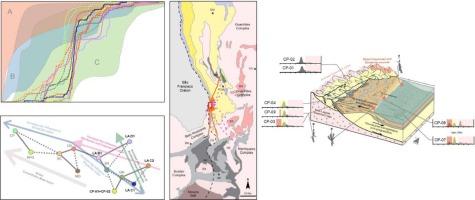中新生代裂谷演替的构造地层框架和产状:以巴西东南部埃斯皮纳索超群为例
IF 3.2
2区 地球科学
Q2 GEOSCIENCES, MULTIDISCIPLINARY
引用次数: 0
摘要
在中新生代,罗迪尼亚超大陆的合并见证了由 "格勒维里类型时代 "造山系统远距离诱发的无数次板块内断裂事件。构造与沉积之间的密切联系使我们能够重建这些板内断裂周期,并将它们与克拉通边缘的增生事件联系起来。这对于了解中新生代大陆的古构造历史至关重要。在巴西东南部,埃斯皮纳索超群记录了从古新生代到中新生代延伸到圣弗朗西斯科古大陆东部边界的长期叠加断裂事件。在埃斯皮纳索超群内发现了三个与地壳不符的断裂序列(1.77-1.7 千亿年;1.57-1.5 千亿年;1.19 千亿年),其末端为康塞莱罗马塔群的下陷海相沉积。在埃斯皮纳索山脉南部(西波山脉)的南延伸段,对地层定位不明的裂谷相关序列进行了详细的沉积学和地层学研究。该层序底部为南埃斯皮纳索超群加尔霍-杜米格尔地层的风化沉积物,顶部为埃迪卡拉-寒武纪碳酸盐岩和班布伊组的辉长岩。对构造引起的沉积控制的产地特征的研究包括地层调查和锆石碎片的 U-Pb 地球时序数据。与断裂有关的序列下段向东过渡到圣丽塔地层中的康塞莱罗马塔组海洋沉积物,现在被确定为下部成员。该地层的最大沉积年龄为 1660 ± 32 Ma,直接覆盖在 Galho do Miguel 地层之上的是一个侵蚀性不整合层位,包括在一个倒置的半沟谷结构中来自冲积和河流系统的同步漂移粗粒沉积物。圣塔里塔地层下统提供了与康塞莱罗马塔组相关的中新生代断裂事件的证据。未定义序列的海洋沉积物的最大沉积年龄为 1462 ± 19 Ma,覆盖在圣塔地层下部的是一个侵蚀性不整合层位。该层序的地层位置仍有待推测,可能与中新生代康塞莱罗马塔断裂事件的后期延伸阶段或导致新新生代马考巴斯群的两个大陆断裂阶段之一有关。本文章由计算机程序翻译,如有差异,请以英文原文为准。

Tectonostratigraphic framework and provenance of a Mesoproterozoic rift succession: An example from the Espinhaço Supergroup, SE Brazil
During the Mesoproterozoic era, the amalgamation of the Rodinia supercontinent witnessed numerous intraplate rifting events far-field induced by “Grenvillian-type age” orogenic systems. The intimate connection between tectonics and sedimentation enables the reconstruction of these intraplate rifting cycles, linking them to accretionary events along craton margins. This is essential for understanding the paleotectonic history of continents during the Mesoproterozoic era. In southeastern Brazil, the Espinhaço Supergroup documents long-lasting superimposed rifting events that extended to the eastern border of the São Francisco paleocontinent from the Paleoproterozoic to the Mesoproterozoic era. Three unconformity-bound rift sequences (∼1.77–1.7 Ga; ∼1.57–1.5 Ga; and ∼ 1.19 Ga) have been identified within the Espinhaço Supergroup, terminated by sag-marine deposits of the Conselheiro Mata Group. In the southern extension of the southern Espinhaço range (Cipó range), a detailed sedimentological and stratigraphic study was conducted on a rift-related sequence with unknown stratigraphic positioning. This sequence is bounded at the base by eolian sediments of the Galho do Miguel Formation of the Southern Espinhaço Supergroup and at the top by Ediacaran-Cambrian carbonates and pelites of the Bambuí Group. Examination of the tectonically-induced depositional controls in the provenance signatures involved stratigraphic surveys coupled with U-Pb geochronological data of detrital zircons. The lower section of the rift-related sequence transitions eastward into marine sediments of the Conselheiro Mata Group within the Santa Rita Formation, now identified as the Lower Member. With a maximum depositional age of 1660 ± 32 Ma, this section directly overlies the Galho do Miguel Formation by an erosive unconformity, comprising syn-rift coarse-grained deposits from alluvial and fluvial systems within an inverted half-graben structure. The Lower Member of the Santa Rita Formation provides evidence of the Mesoproterozoic rifting event associated with the Conselheiro Mata Group. The marine sediments of the Undefined sequence have a maximum depositional age of 1462 ± 19 Ma, overlying the Lower Member of the Santa Rita Formation with an erosive unconformity. The stratigraphic position of this sequence remains speculative, possibly linked to a later extensional phase of the Mesoproterozoic Conselheiro Mata rifting event or one of the two continental rifting stages leading to the Neoproterozoic Macaúbas Group.
求助全文
通过发布文献求助,成功后即可免费获取论文全文。
去求助
来源期刊

Precambrian Research
地学-地球科学综合
CiteScore
7.20
自引率
28.90%
发文量
325
审稿时长
12 months
期刊介绍:
Precambrian Research publishes studies on all aspects of the early stages of the composition, structure and evolution of the Earth and its planetary neighbours. With a focus on process-oriented and comparative studies, it covers, but is not restricted to, subjects such as:
(1) Chemical, biological, biochemical and cosmochemical evolution; the origin of life; the evolution of the oceans and atmosphere; the early fossil record; palaeobiology;
(2) Geochronology and isotope and elemental geochemistry;
(3) Precambrian mineral deposits;
(4) Geophysical aspects of the early Earth and Precambrian terrains;
(5) Nature, formation and evolution of the Precambrian lithosphere and mantle including magmatic, depositional, metamorphic and tectonic processes.
In addition, the editors particularly welcome integrated process-oriented studies that involve a combination of the above fields and comparative studies that demonstrate the effect of Precambrian evolution on Phanerozoic earth system processes.
Regional and localised studies of Precambrian phenomena are considered appropriate only when the detail and quality allow illustration of a wider process, or when significant gaps in basic knowledge of a particular area can be filled.
 求助内容:
求助内容: 应助结果提醒方式:
应助结果提醒方式:


